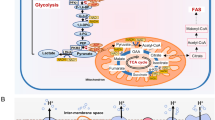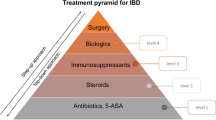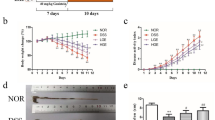Abstract
Background
The hyperhomocysteinaemia (Hhcy) is a common phenomenon observed in patients with inflammatory bowel disease (IBD). Our previous study showed that Hhcy aggravated intestinal inflammation in an animal model of colitis. Increased levels of IL-17 and RORγt were also observed in this animal model of colitis with Hhcy. However, the direct effect of homocysteine on the differentiation of Th17 cells has never been studied. The aim of this study was to investigate the direct effect of Hhcy on the differentiation of CD4+ T cells into Th17 cells.
Method
Lamina propria lymphocytes (LPLs) in colonic mucosa of Wistar rats were isolated and cultured under Th17-inducing (iTH17) environments. Different concentrations of the Hcy (0–100 μmol/ml) were added alone or combined with IL-23 (100 ng/ml) or folate (5 μmol/ml). The LPLs were divided into eight groups as follows: (1) Control group; (2) 10 μmol/ml Hcy group; (3) 25 μmol/ml Hcy group; (4) 50 μmol/ml Hcy group; (5) 100 μmol/ml Hcy group; (6) 100 ng/ml IL-23 group; (7) 50 μmol/ml Hcy + 100 ng/ml IL-23 group and (8) 50 μmol/ml Hcy + 100 ng/ml IL-23 + 5 μmol/ml folate group. The protein expression levels of IL-17, retinoid-related orphan nuclear receptor-γt (RORγt), p38 MAPK, phosphorylated p38 MAPK, cytosolic phospholipase A2 (cPLA2), phosphorylated-cPLA2 and cyclooxygenase 2 (COX2) were detected by immunoblot analysis. The protein level of prostaglandin E2 (PGE2) and IL-17 was detected by ELISA, and IL-17 and RORγt-positive CD4+ T cells were stained and analyzed by flow cytometry.
Results
Hcy increased the protein levels of IL-17, RORγt, the ratio of phosphorylated p38 MAPK to p38 MAPK (p-p38/p38), the ratio of phosphorylated cPLA2 to cPLA2 (p-cPLA2/cPLA2) and COX2. The effect was concentration dependent to a certain degree; Hcy of 50 μmol/ml was the optimal concentration to increase the protein levels of those molecules. The level of IL-17 and PGE2 in the cell culture supernatants and the expression of IL-17 and RORγt in positive CD4+ T cells were also increased in the group of Hhcy. IL-23 showed a cooperative effect with Hcy on the differentiation of CD4+ Th cells into Th17 cells, whereas folate supplementation showed an inhibition action.
Conclusions
Homocysteine promoted the differentiation of CD4+ T cells into Th17 cells in a dose-dependant manner. This effect could be inhibited by folate.






Similar content being viewed by others
References
Soubieres AA, Poullis A. Emerging biomarkers for the diagnosis and monitoring of inflammatory bowel diseases. Inflamm Bowel Dis. 2016;22:2016–2022.
Baumgart DC, Carding SR. Inflammatory bowel disease: cause and immunobiology. Lancet. 2007;369:1627–1640.
Patel DD, Kuchroo VK. Th17 cell pathway in human immunity: lessons from genetics and therapeutic interventions. Immunity. 2015;43:1040–1051.
Friedrich M, Diegelmann J, Schauber J, et al. Intestinal neuroendocrine cells and goblet cells are mediators of IL-17A-amplified epithelial IL-17C production in human inflammatory bowel disease. Mucosal Immunol. 2015;8:943–958.
Ray S, De Salvo C, Pizarro TT. Central role of IL-17/Th17 immune responses and the gut microbiota in the pathogenesis of intestinal fibrosis. Curr Opin Gastroenterol. 2014;30:531–538.
Honzawa Y, Nakase H, Shiokawa M, et al. Involvement of interleukin-17A-induced expression of heat shock protein 47 in intestinal fibrosis in Crohn’s disease. Gut. 2014;63:1902–1912.
Zenewicz LA, Antov A, Flavell RA. CD4 T-cell differentiation and inflammatory bowel disease. Trends Mol Med. 2009;15:199–207.
Fossiez F, Djossou O, Chomarat P, et al. T cell interleukin-17 induces stromal cells to produce proinflammatory and hematopoietic cytokines. J Exp Med. 1996;183:2593–2603.
Nalbant A, Eskier D. Genes associated with T helper 17 cell differentiation and function. Front Biosci. 2016;8:427–435.
Bettelli E, Oukka M, Kuchroo VK. TH-17 cells in the circle of immunity and autoimmunity. Nat Immunol. 2007;4:345–350.
Kallel L, Feki M, Sekri W, et al. Prevalence and risk factors of hyperhomocysteinemia in Tunisian patients with Crohn’s disease. J Crohns Colitis. 2011;5:110–114.
Peyrin-Biroulet L, Gueant-Rodriguez RM, Chen M, et al. Association of MTRR 66A > G polymorphism with superoxide dismutase and disease activity in patients with Crohn’s disease. Am J Gastroenterol. 2008;103:399–406.
Danese S, Sgambato A, Papa A, et al. Homocysteine triggers mucosal microvascular activation in inflammatory bowel disease. Am J Gastroenterol. 2005;100:886–895.
Zhu S, Li J, Bing Y, et al. Diet-induced hyperhomocysteinaemia increases intestinal inflammation in an animal model of colitis. J Crohn’s Colitis. 2015;9:708–719.
Reissig S, Hackenbruch C, Hovelmeyer N. Isolation of T cells from the gut. Methods Mol Biol. 2014;1193:21–25.
Weigmann B, Tubbe I, Seidel D, et al. Isolation and subsequent analysis of murine lamina propria mononuclear cells from colonic tissue. Nat Protoc. 2007;2:2307–2311.
Di Sabatino A, Pender SL, Jackson CL, et al. Functional modulation of Crohn’s disease myofibroblasts by anti-tumor necrosis factor antibodies. Gastroenterology. 2007;133:137–149.
Ivanov II, McKenzie BS, Zhou L, et al. The orphan nuclear receptor ROR gammat directs the differentiation program of proinflammatory IL-17 + T helper cells. Cell. 2006;126:1121–1133.
Donaldson DS, Bradford BM, Artis D, et al. Reciprocal regulation of lymphoid tissue development in the large intestine by IL-25 and IL-23. Mucosal Immunol. 2015;8:582–595.
Schicho R, Marsche G, Storr M. Cardiovascular complications in inflammatory bowel disease. Curr Drug Targets. 2015;16:181–188.
Keshteli AH, Baracos VE, Madsen KL. Hyperhomocysteinemia as a potential contributor of colorectal cancer development in inflammatory bowel diseases: a review. World J Gastroenterol. 2015;21:1081–1090.
Casella G, Antonelli E, Di Bella C, et al. Hyperhomocysteinemia in patients with Crohn’s disease. Tech Coloproctol. 2013;17:497–500.
Feng J, Lu S, Ding Y, et al. Homocysteine activates T cells by enhancing endoplasmic reticulum-mitochondria coupling and increasing mitochondrial respiration. Protein Cell. 2016;7:391–402.
Andersohn F, Waring M, Garbe E. Risk of ischemic stroke in patients with Crohn’s disease: a population-based nested case-control study. Inflamm Bowel Dis. 2010;16:1387–1392.
Peyrin-Biroulet L, Rodriguez-Gueant RM, Chamaillard M, et al. Vascular and cellular stress in inflammatory bowel disease: revisiting the role of homocysteine. Am J Gastroenterol. 2007;102:1108–1115.
Guilland JC, Favier A, Potier DCG, et al. Hyperhomocysteinemia: an independent risk factor or a simple marker of vascular disease? Pathol Biol. 2003;51:101–110.
Oussalah A, Gueant JL, Peyrin-Biroulet L. Meta-analysis: hyperhomocysteinaemia in inflammatory bowel diseases. Aliment Pharmacol Ther. 2011;34:1173–1184.
Ding H, Mei Q, Gan HZ, et al. Effect of homocysteine on intestinal permeability in rats with experimental colitis, and its mechanism. Gastroenterol Rep. 2014;2:215–220.
Gaffen SL, Jain R, Garg AV, et al. The IL-23-IL-17 immune axis: from mechanisms to therapeutic testing. Nat Rev Immunol. 2014;14:585–600.
Kaser A, Zeissig S, Blumberg RS. Inflammatory bowel disease. Annu Rev Immunol. 2010;28:573–621.
Abraham C, Cho J. Interleukin-23/Th17 pathways and inflammatory bowel disease. Inflamm Bowel Dis. 2009;15:1090–1100.
Maloy KJ. The Interleukin-23/Interleukin-17 axis in intestinal inflammation. J Intern Med. 2008;263:584–590.
Cox JH, Kljavin NM, Ota N, et al. Opposing consequences of IL-23 signaling mediated by innate and adaptive cells in chemically induced colitis in mice. Mucosal Immunol. 2012;5:99–109.
Mahmud N, Molloy A, McPartlin J, et al. Increased prevalence of methylenetetrahydrofolate reductase C677T variant in patients with inflammatory bowel disease, and its clinical implications. Gut. 1999;45:389–394.
Cianciulli A, Salvatore R, Porro C, et al. Folic acid is able to polarize the inflammatory response in LPS activated microglia by regulating multiple signaling pathways. Mediat Inflamm. 2016;2016:1–10.
Wang N, Tang H, Wang X, et al. Homocysteine upregulates interleukin-17A expression via NSun2-mediated RNA methylation in T lymphocytes. Biochem Biophys Res Commun. 2017;493:94–99.
Geginat J, Paroni M, Kastirr I, et al. Reverse plasticity: TGF-beta and IL-6 induce Th1-to-Th17-cell transdifferentiation in the gut. Eur J Immunol. 2016;46:2306–2310.
Acknowledgments
This study was supported by Grants from National Natural Science Foundation of China (No. 8110026).
Author information
Authors and Affiliations
Corresponding author
Ethics declarations
Conflict of interest
The authors declared no financial conflict of interest.
Rights and permissions
About this article
Cite this article
Gao, X., Li, J. & Chen, M. Effect of Homocysteine on the Differentiation of CD4+ T Cells into Th17 Cells. Dig Dis Sci 63, 3339–3347 (2018). https://doi.org/10.1007/s10620-018-5177-2
Received:
Accepted:
Published:
Issue Date:
DOI: https://doi.org/10.1007/s10620-018-5177-2




